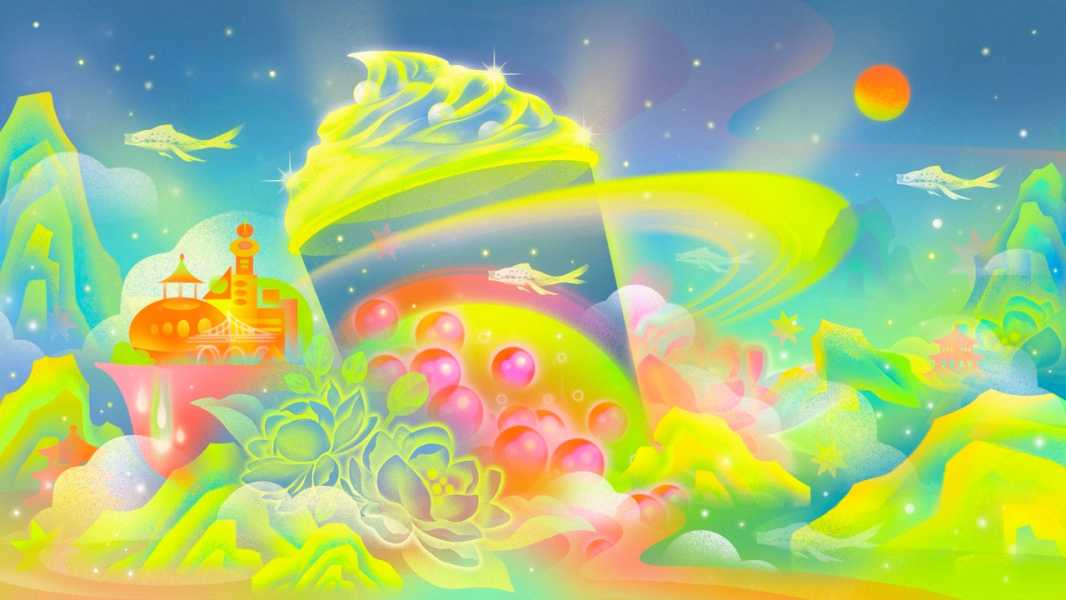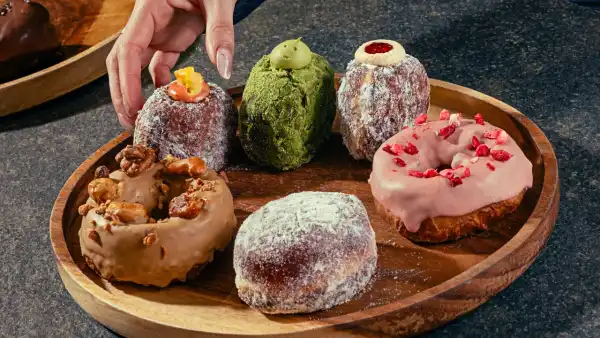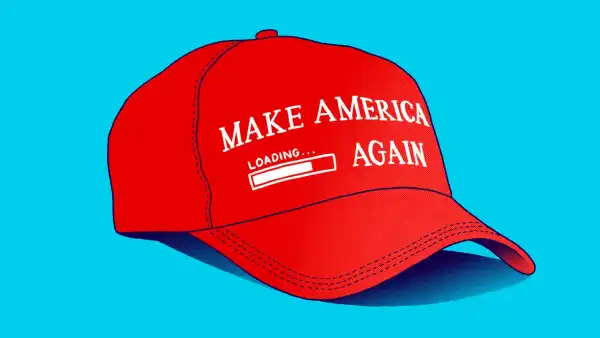
Save this storySave this storySave this storySave this story
As a nineties kid who grew up drinking bubble tea, I long ago wrote the drink off as a cheap indulgence, whose satisfying sugar rush quickly metabolizes into lingering regret. That changed last fall, when I visited China for the first time in years and encountered the country’s new generation of milk-tea chains—establishments that sell not only beverages but also imagined worlds. At Chayan Yuese, a chain whose aesthetic celebrates the culture of antiquity, the staff greeted me as xiaozhu (“your ladyship”). I ordered a “valley orchid latte,” and a brochure in the style of ink-wash painting instructed me to start with the “mountain peak” of the drink’s milky foam, before eventually reaching the “foothills” of richly mixed Ceylon tea. At Chagee, which uses cups printed with cobalt patterns reminiscent of blue-and-white porcelain, choosing a product on the menu was like selecting a literary adventure: I settled on a jasmine milk tea named for Bo Ya, a legendary musician of the Spring and Autumn period, some twenty-five hundred years ago, who is said to have broken his zither after the death of the only friend who he thought understood his music. At 3Bro Factory, the nostalgia fast-forwarded to the Communist era: in a red-and-green space designed to recall a state-owned factory floor, it served bougie drinks, such as a silky blend of milk and Tieguanyin oolong. If a Brooklynite had shown up in Novesta plimsolls and a two-hundred-dollar worker’s jacket, I wouldn’t have batted an eye.
People have been using milk or cream to mellow the bitter tannins of black tea for centuries. In the nineteenth century, the British began complementing their afternoon teas, brewed using Indian leaves, with milk and sugar; in the Himalayas, nomadic people still add yak butter or yak milk, following time-honored habits. In East Asia, though, the most influential formulation of milk tea—a mélange of black tea and creamer, accompanied by tapioca pearls—originated in Taiwan in the eighties, before travelling to the mainland just as the Chinese economy was rising. Although the addition of milk was not a traditional feature of Chinese tea culture, the drink became incredibly popular, spawning an industry dominated by a handful of chains, though one could also buy it at tiny storefronts and streetside stalls. (By now, the drink has become a common sight in Chinatowns worldwide, including in the U.S., where it is usually called “bubble tea” or “boba.”)
For more than a decade, small tweaks to the traditional cup, along with a standardized lexicon of modifications (for warmth, sugar quantity, and ice level), represented the business’s key innovations. But, in the past few years, hundreds of thousands of new stores have opened in China, boasting expansive menus filled with what are known as xinchayin, or “new tea drinks.” With their fancy ingredients and highly involved storytelling, these businesses put Starbucks’ seasonal pumpkin spice to shame. Chagee, which sells a hundred million cups of “Bo Ya” annually, emphasizes that its jasmine-infused green-tea buds are picked exclusively in early spring. The chain Auntea Jenny is known for its unusual pairings—for instance, mulberries or hawthorn with Maofeng green tea. On Xiaohongshu, China’s answer to Instagram, influencers rate menu items in posts tagged “new tea drinks evaluation.” According to a report by the tea-research institute at the Chinese Academy of Agricultural Sciences, by 2022, xinchayin chains had reached about forty billion dollars in sales. The industry is growing so quickly that one common scam involves fake Web sites posing as renowned brands offering franchise opportunities.
HEYTEA is widely considered an industry leader, operating more than four thousand stores. When I visited its top-selling location, in a shopping mall in Beijing, I ordered its famous matcha latte topped with a layer of frothy cheese, which tasted like tangy whipped cream. Decorated in muted grays and stainless steel, the place evoked a minimalist spaceship. Deliverymen wearing yellow helmets decorated with plastic kangaroo ears, a signature of the food-delivery giant Meituan, were waiting around when an upbeat digital voice announced, “Customer five thousand and four has already waited for three minutes!”
When I spoke with some of the company’s staff members on WeChat, they were gathered in a conference room in their headquarters in Shenzhen. Like most of HEYTEA’s more than ten thousand employees, they were either young millennials or Gen Z-ers. The head of operations, the thirty-year-old He Qinman, told me that she joined the business in 2012, when she graduated from high school and responded to an ad outside a tiny, newly opened milk-tea shop in Jiangmen, a city in Guangdong. The establishment’s owner was Nie Yunchen, a recent graduate of a technical college, who had a degree in administrative management. Within a year or two, the shop gained a loyal following and began to expand to other cities. By 2018, it had received more than seventy million dollars of venture-capital investment; two years later, Nie, then twenty-nine, was reportedly worth about six hundred million.
HEYTEA has since expanded overseas, to Australia, Singapore, and the U.K. In December, a location opened just off Times Square, in New York City. On its first day, the store drew an hours-long queue; one blogger live-streamed it so that fans could strategize when best to visit. She appropriated a line from Pushkin’s “If by Life You Were Deceived” to encourage her followers who struggled to secure order slots: “Don’t be dismal, don’t be wild. When you have a minute, refresh your HEYTEA app.”
The extent to which xinchayin have swept China’s malls and smartphones in the past few years reflects a radical transformation of consumer culture, powered by immense reserves of labor, entrepreneurial ingenuity, investment money, and, crucially, an extremely competitive delivery infrastructure. HEYTEA estimates that seventy to eighty per cent of its domestic purchases are online orders. Thanks to the rise of platforms like WeChat and Meituan, it’s estimated that there are more than ten million food-delivery workers in China. According to Meituan’s own research, its average meal delivery time is twenty-eight minutes, whereas Uber Eats or DoorDash’s are about thirty-five minutes. In 2022, Meituan optimized its algorithm so that workers spent almost twenty per cent less time waiting for popular restaurants to fulfill orders. Delivery is often free of charge.
“The whole society is very demanding when it comes to efficiency,” Huang Hui, a professor of economics and social policy at Shanghai Jiao Tong University, told me. For years, Huang has been interviewing delivery workers. One of them confessed that his job felt like an endless game of Temple Run. By making more deliveries, he could advance to a higher “tier” and be paid more per order, but he could do so only by working without breaks. At one point, Huang himself signed up to deliver food. For the first two weeks, he kept exceeding the delivery window set by the algorithm, so the system deducted penalties from his account—sometimes beyond what he was paid for the order. (In 2020, Meituan announced that it would begin to give workers grace periods of eight minutes.) “Chinese customers’ expectation for speedy delivery could never be met in the U.S.,” Yang Fan, a professor of media and globalization at the University of Maryland, Baltimore County, said. “If they visit America, they’d think things are so backward.”
Scarcely a generation ago, China had nothing resembling mass consumption whatsoever—many goods could be purchased only with ration coupons, and the idea of “brands” didn’t really exist. Today, however, its consumer culture often feels even more evolved than that of the West. Where lining up for something once signified scarcity—there were certain things you couldn’t buy even if you had the money—queuing up outside a shop now represents participation in an exciting consumer moment. According to New Game Theory, a WeChat blog focussed on business, HEYTEA unveiled seventy-four collaborations between 2017 and 2021, with partners including Fendi, Benefit Cosmetics, Nike, Sesame Street, Durex, Studio Ghibli, and even one of its rivals, Chayan Yuese. The company’s Chinese name is Xi Cha, meaning “tea of joy,” and, in 2022, it worked with municipal Bureaus of Civil Affairs to gift drinks to newlyweds.
A notable feature of recent milk-tea marketing is the aesthetic that’s come to be known as guochao (literally, “national and hip”), which combines millennial design cues with references to traditional Chinese elements: a pagoda here, a lotus leaf there. Guochao defines the look of many new brands, including Huaxizi, a makeup line that emphasizes floral ingredients, and To Summer, a fragrance label that sells scents such as Osmanthus in Beijing and Magnolia in Shanghai. Last year, the coffee chain Luckin released a wildly successful collaboration with the liquor company Kweichow Moutai, which produces an old-school premium spirit, primarily associated in the popular imagination with middle-aged businessmen binge-drinking at cigarette-smoke-filled banquets. For the first time, the coffee company saw its annual sales overtake those of Starbucks’ Chinese subsidiary.
Surveying these offerings, it’s hard to miss a rising sense of self-assurance. For decades, Chinese consumers were quick to associate imported products with superior quality, but, according to Deloitte, by 2023, less than a quarter of them preferred foreign goods to domestically produced ones. Tellingly, this boom has taken place during a period of increasing government control over cultural and political expression. Fewer literary titles are being published; renowned filmmakers struggle to get their films released; professors whisper about colleagues who have been reported to the Party’s disciplinary committees; feminist, civil-rights, and labor activism have been stifled. The cultural historian Carl E. Schorske observed that, in societies with narrowing political outlets—such as the one he wrote about in his famous study “Fin-De-Siecle Vienna”—the creative class tends to turn its gaze inward, retreating to the psychological and to the pursuit of personal desires. In China, a newly enriched and creatively gifted segment of the population invests itself in commerce to fill the void left behind by a restricted cultural life. And even commercial expression has its limits. A recent HEYTEA collaboration that featured cartoon Buddhas was suspended by the authorities for “using religion for commercial advertising.”
HEYTEA’s napkins are printed with famous lines by the Song-dynasty statesman and poet Fan Zhongyan: “Neither overjoyed by material objects, nor saddened by personal losses.” Fan was banished several times in his life, and many of his poems gesture at the experience that today’s wellness gurus might call “ego death.” During our WeChat call, the staffers discussed the significance of the company’s namesake term, “joy.” “It’s different from being really happy or thrilled, which is a rush that comes fast and leaves fast,” Ni Tingting, a brand manager, said. “Joy, on the other hand, is like a slender stream that runs steadily. If you love life, you have joy in your heart. You are in a state of ease, and don’t need material goods to stimulate happiness.” The head of publicity, Cheng Hao, chimed in. “Joy is deeper and more Eastern,” he said. “It fits Chinese cultural characteristics better.” Of course, a speedily delivered, fragrant cup of milk tea wouldn’t hurt. ♦
Sourse: newyorker.com






